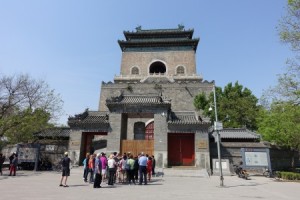 Sometimes small historic treasures are located in obscure places. On our second day in China, we visited a small segment of historic Beijing. Our first stop was a medium sized open area that had a Bell Tower on the north end and a Drum Tower on the south end. In between these two structures was an open area that was labeled Culture Square.
Sometimes small historic treasures are located in obscure places. On our second day in China, we visited a small segment of historic Beijing. Our first stop was a medium sized open area that had a Bell Tower on the north end and a Drum Tower on the south end. In between these two structures was an open area that was labeled Culture Square.
According to a posted sign, this was the site of the original Beijing Bell Tower. The Bell Tower was constructed in the 13th century and was destroyed by a fire. A replacement was built in the 15th century during the Ming Dynasty. Once again, it was destroyed by fire. The picture posted above was constructed under the reign of Qianlong during the 18th century.
The Bell Tower is composed of brick and stone masonry with a hip and gable roof that is covered with black glazed tiles and green glazed trim at the top. It is approximately 48 meters high. A bronze bell hangs from the second floor. It weighs 63 tons. The bell has a bold sound that can be heard up to 5 km away. It was nicknamed the “king of the ancient bells.”
This historic structure was a prominent feature during the Yuan, Ming and Qing Dynasties. It’s purpose was to announce the time throughout the city. As a result it is protected by the State Council of the People’s Republic of China.
Next, we walked through an older neighborhood and passed a sign for Doufuchi Hutong. This area runs from east to west for a total of 477 meters. The sign described how the area was divided and renamed several times. Mao Zedong lived here during his early years. However, we did not pass his notable residence.
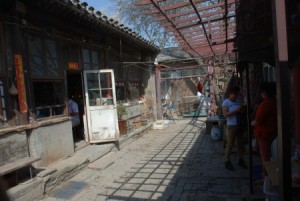
Instead, we continued to stroll through an older neighborhood. Eventually, we walked to one of the homes that was located inside a courtyard.
We were warmly greeted by a man who could not speak English.
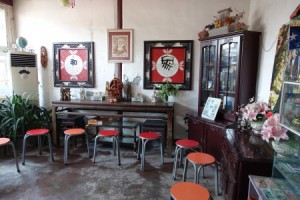
Our tour guide translated the man’s story as our large group crowded into two adjacent rooms. While most of his neighbors had opted to relocate to modern high rise buildings outside the center of the city, he chose to remain within Beijing’s first ring.
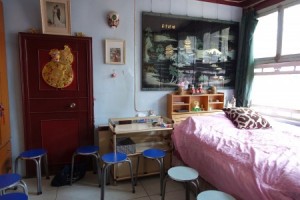
His possessions were meager and the accommodations were simple and primitive. He had to walk several blocks to use a public restroom and bathing facilities.
Next we went to an area where there was a long line of rickshaws. The bicycle driven rickshaws weaved through this area so that we could get a glimpse of one of the few remaining historic areas of Beijing. The narrow passageways and obstacles made it impossible to capture the experience in digital images.
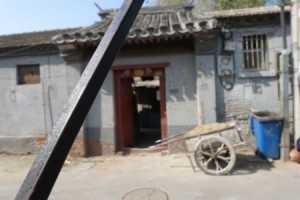
A significant number of these courtyard homes were being modernized and renovated while others looked run down and badly in need of repair.
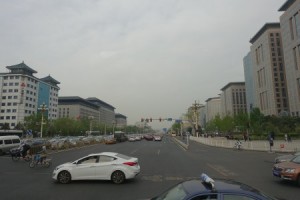
Looking at Beijing’s modern and polluted skyline, it’s hard to image a time when all of the people in Beijing lived in rudimentary structures. As each block was torn down, the people had to endure tremendous adjustments as they were uprooted and relocated to modern buildings miles away.
In light of all of the modernization, it was a pleasant surprise to see a willingness of the Chinese government not to destroy all of Beijing’s early architecture. The rickshaw ride and the visit to a courtyard home may have been infused with a heavy dose of propaganda and tourism, but it did provide a small glimpse of earlier times.
Related Posts
Sandra’s Bio
Sandra Bornstein is the author of MAY THIS BE THE BEST YEAR OF YOUR LIFE. It is available on Amazon. Sandra’s memoir highlights her living and teaching adventure in Bangalore, India. She is a licensed Colorado teacher who has taught K-12 students in the United States and abroad as well as college level courses. Sandra is married and has four adult sons. The memoir was a finalist in the Travel category for the 2013 Next Generation Indie Book Awards, the 2013 International Book Awards, the 2013 National Indie Book Excellence Awards, the 2013 USA Best Book Awards, and received an Honorable Mention award in the Multicultural Non-Fiction category for the 2013 Global ebook Awards.
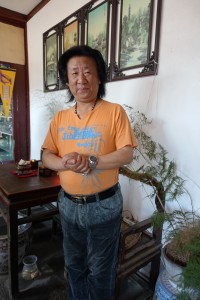
Leave a Reply
You must be logged in to post a comment.